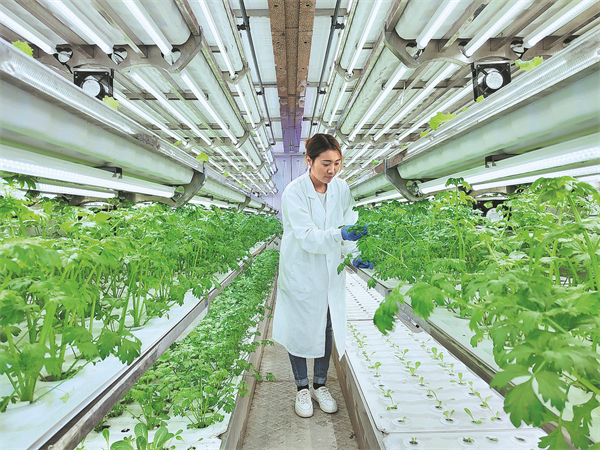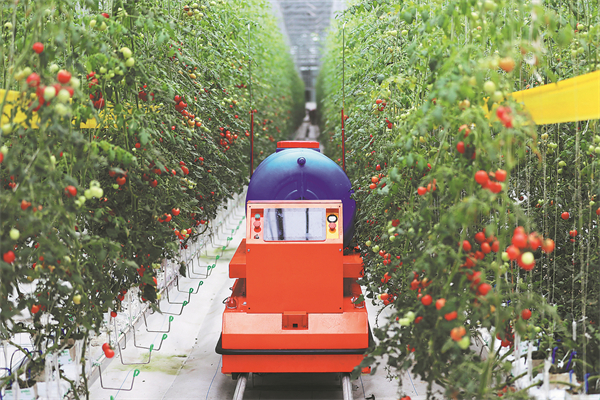
- Home
- Media Center
-
Events
- Wuzhen Summit
- Regional Forums
- Practice Cases of Jointly Building a Community with a Shared Future in Cyberspace
- World Internet Conference Awards for Pioneering Science and Technology
- The Light of Internet Expo
- Straight to Wuzhen Competition
- Global Youth Leadership Program
- WIC Distinguished Contribution Award
- Membership
- Research & Cooperation
- Digital Academy
-
Reports
- Collection of cases on Jointly Building a Community with a Shared Future in Cyberspace
- Collection of Shortlisted Achievements of World Internet Conference Awards for Pioneering Science and Technology
- Reports on Artificial Intelligence
- Reports on Cross—Border E—Commerce
- Reports on Data
- Outcomes of Think Tank Cooperation Program
- Series on Sovereignty in Cyberspace Theory and Practice
- Other Achievements
- About WIC
- 中文 | EN

Life made easier as farmers turn to tech

A technician tends to plants grown in a shipping container in Shouguang, Shandong province. [Yang Jun/For China Daily]
Robots and other devices taking agriculture into the future
At an agricultural technology company in a city known as the "vegetable capital of China", crops are thriving in a shipping container.
The roots of these green-leaf vegetables are immersed in water rich in nutrients. A screen in the container shows information about the temperature, humidity, concentration of carbon dioxide, the lighting levels and concentration of the nutrient solution.
Liu Pengpeng, who oversees the container vegetable project at Shouguang Xiangtian Agriculture Co in Jitai town, Shouguang, said it takes 28 days for these vegetable seedlings to grow before they can be harvested and put on the market.
"Using hydroponic systems, we designed this mobile shipping container vegetable farm, which can withstand severe weather conditions for fresh vegetables to be grown locally all year round," Liu said.
"In comparison, in Xinjiang Uygur autonomous region, workers who build railways and highways in sparsely populated areas have to drive more than 50 kilometers to buy fresh vegetables."
Liu, who has worked in Xinjiang for several years, added, "The container farm enables workers to grow fresh vegetables by themselves."
After three years' work analyzing data collected by sensors installed in the containers, the company developed a comprehensive manual containing instructions on how to grow the vegetables.
"Good crops are being produced at container farms with the help of these manuals, which show how to set the controls for the systems that provide everything the vegetables need, such as nutrients and automatic lighting," Liu said.
A 40-foot shipping container is typically used to grow some 5,000 green-leaf vegetables on the equivalent of 0.13 hectares of farmland, he said.
Since launching the first hydroponic container farm in 2017, the company has sold more than 40, mainly to customers in countries such as Canada, Russia, Malaysia, Uzbekistan and the United Arab Emirates.
It expects to sell more than 2,000 farms this year as businesses recover from the COVID-19 pandemic.
Based on the hydroponic systems, farmers in Huimin county, Binzhou, developed a deep flow technique to grow chives.
Wei Kun, a technician at Shandong Xincheng Agriculture Co, which is based in Huimin, said, "The roots of chives grow in a nutrient water solution of 10 to 30 centimeters, which ensures the plants have sufficient nutrients and oxygen."
Crops grown by using hydroponic systems are not affected by chive maggots, a pest that attacks the roots, Wei said.
"In our greenhouse, we don't need to use pesticides on the chives," Wei said, adding that the crops are welcomed at markets.
Along with hydroponic systems, vegetable-growing technologies are used widely by farmers in Shandong to grow healthy food and to make their work easier.

A robotic device operates in a smart greenhouse in Shouguang. [Photo provided to China Daily]
Smart greenhouses
At a demonstration base in Shouguang for modern agricultural techniques, a smart glass greenhouse being used to grow tomatoes features more than 120 patented technologies developed by a team from the Chinese Academy of Engineering.
Data showing humidity, temperature and carbon dioxide levels are updated on a large electronic screen in the greenhouse.
Covering about 80,000 square meters, the area occupied by 11 standard soccer fields, the greenhouse requires few workers. Instead, robots and other devices are used to pick and transport the tomatoes.
Wang Haiguang, deputy director of the operations office at the greenhouse, said, "As it would be very difficult to manage such a big structure with a human labor force, we use a cloud management system to maintain the right conditions for the crops."
Sensors collect information about humidity, water, fertilizer, sunlight, heat and ventilation, which is uploaded to a platform to be analyzed. Based on the analysis, the correct levels of water and fertilizer are supplied to the crops by the automatic irrigation system, Wang said.
With air-source heat pumps and facilities to store heat, the structure does not consume huge amounts of energy in winter, unlike traditional greenhouses.
"Growing crops in a controlled environment enables farmers to produce high-quality plants, maintain high food safety standards, and avoid the use of pesticides," Wang said.
In addition to the smart greenhouses, organizations such as the Chinese Academy of Agricultural Sciences, Chinese Academy of Sciences, and the National Research Center for Information Technology in Agriculture are developing greenhouses at the demonstration base by using state-of-the-art technologies on a trial basis.
These structures include new-material greenhouses, those with sliding covers, and assembled prefabricated greenhouses.
Wang said, "Many of the newly developed technologies have been promoted for widespread use among farmers."
For example, in Cuilingxi village, farmer Cui Xinzhong uses his smartphone as a "highly efficient and valuable agricultural tool".
In one of Cui's greenhouses, which occupies 2,600 sq m and grows tomatoes, an electronic screen shows data about the interior conditions, such as the temperature and pH value of the soil, which refers to its concentration of hydrogen.
Cui uses his phone to control smart systems in his greenhouses. When he clicks on the irrigation button, the system begins watering the tomatoes.
The greenhouse also features smart devices to adjust fertilizer levels and the lighting.
"Years ago, growing vegetables in a single greenhouse was tiring work, but now my wife and I grow them in three greenhouses," Cui said.
Greenhouses equipped with smart systems based on the internet of things and big data account for more than 80 percent of the total number in Shouguang, according to the city government. Shouguang now boasts 173,000 greenhouses producing 4.5 million metric tons of vegetables annually.

A smart greenhouse used to grow tomatoes in Shouguang features more than 120 patented technologies developed by a team from the Chinese Academy of Engineering. [Photo provided to China Daily]
Soilless technologies
Farmers in northern Shouguang, which has soil with a high salt content, produce tomatoes by using soilless growing technologies.
In villages at the Shuangwangcheng Ecological Economy Development Center, these crops are produced by such methods that use a mix of sand and cinder.
Farmers in the area said 60,000 yuan ($8,736) worth of tomatoes can be produced on each mu (0.067 hectares) of land on which such methods are used.
Two decades ago, farmers in these villages only earned 500 yuan from each mu of land due to the soil's high salt content.
Han Xiangjun, who farms in Nanqiaomu village, said, "The local soil used to be dubbed 'white land', as the high salt content left a distinctive 'frost' on the top layer.
"On this soil, we could only plant cotton, which had a low yield."
Farmers in the village have used soilless technologies to grow tomatoes in greenhouses since 2000.
"We use a drip irrigation system to water the crops and provide them with nutrients, which saves a considerable amount of water," Han said.
"Using a soilless growing mix allows us to produce healthier crops without the threat of soil-born diseases. Plants grown in soilless mixes are also less likely to be affected by pests.
"If the soilless growing system is working correctly, it requires extremely low maintenance, and can result in a high output."
As farmers become skilled in using soilless technologies, they are growing more types of fruit and vegetables to increase their earnings.
Cui, the Cuilingxi villager, said: "Smart technologies have made our work much easier and more efficient. Being a farmer is no longer as hard as it used to be."

The World Internet Conference (WIC) was established as an international organization on July 12, 2022, headquartered in Beijing, China. It was jointly initiated by Global System for Mobile Communication Association (GSMA), National Computer Network Emergency Response Technical Team/Coordination Center of China (CNCERT), China Internet Network Information Center (CNNIC), Alibaba Group, Tencent, and Zhijiang Lab.





